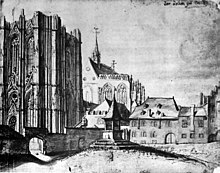Thomas Sergryphius
Thomas Sergryphius (* before 1600 in Florence ; † October 4, 1630 in Cologne ) was a theologian and master's degree . He taught at the old University of Cologne .
Career
An exact year of birth or details about the youth of Thomas Sergryphius from Tuscany is not known. He studied among others 1612/14 at the University of Salamanca , a former center of scholastic studies, and received in Paris the Bachelor of Theology .
Faculty and teaching in Cologne
Sergryphius moved to Cologne, where he probably entered the Dominican order there (Order of Preachers, or "conv. S. Crucis Coloniae") in Stolkgasse. He then matriculated at the University of Cologne, whose faculty facilities at that time were spread over several buildings, but almost all of which were in the same district near the monastery.
At the time of Sergryphius, the "Aula theologica" was set up in a new building built in 1523 next to the south tower of the cathedral at the cathedral monastery. According to the drawing by Justus Finkenbaum, it was a two-storey crenellated building (behind the cathedral immunity wall ), which in turn had to give way to a new building in 1748/50 and then lost its function as a teaching institution during the French era .
After he had taken the necessary "Responsiones pro licentia" there in the first half of 1619, he was allowed to hold the degree licentiatus . Sergryphius was now the governor of the general studies of the Dominican order and as “Lector primarius conv. Colon. ”(Senior lecturer at the Cologne monastery). In October 1621 he was promoted to Dr. theol. PhD .
Arbitrator and envoy
Sergryphius "Lectura" and his licentiate had been expressly recognized by the General Chapter in 1622. In 1627 he was qualified as Magister noster and Dr. theol. and acted, for example, as a representative of the theological faculty in the election of the rector. In the event of differences due to contrary theses in the colleges, Sergryphius presided over the "disputations" that were then scheduled and was usually able to reach an arbitration. Which esteem he enjoyed in his University College, an incident of the year 1629. About showed the university rector was for an alleged breach of duty by the in Liege , who remained Apostolic Nuncio , Pier Luigi Carafa , the excommunication imposed, a measure that at the University of incomprehension bumped. In order to inform the nuncio correctly and to try to settle the matter, Sergryphius was sent to Liège by a unanimous decision of the artist faculty and was able to settle the case there with additional letters from the university.
Legate of the city council
A year earlier, the city council had used the scholar's diplomatic skills for his own interests. Sergryphius, whom the Senate described in a letter as professor in hac nostra Universitate primarius , enjoyed the full confidence of the city. In 1628 he was sent to Rome as a representative (legatus noster) of the city in important matters to present the wishes of the city to the state secretary and Cardinal Francesco Barberini , the cardinal nepot of Pope Utbans (real name Maffeo Barberini from Florence). In his conversation partner he met a man who also came from his hometown Florence and, judging by a later letter of thanks from Cologne to the Pope, had apparently been successful with his mission.
Death of the scholar
The necrology of the Dominican monastery emphasized the merits of the deceased and reported on a contagious disease (pestis contagiosa) that raged in Cologne in 1631/32, to which Father Thomas Sergryphius also fell victim.
literature
- Gabriel M. Löhr, OP Walberberg: The Cologne Dominican monastery in the 17th century. In: Yearbook of the Kölner Geschichtsverein e. V. Cologne 1953. Volume 29.
- Paul Clemen (Hrsg.): The art monuments of the Rhine province. Volume 6, 7: The art monuments of the city of Cologne. Volume 7, section 3, supplementary volume = volume 2, section 3, supplementary volume: Ludwig Arntz , Heinrich Neu, Hans Vogts : The former churches, monasteries, hospitals and school buildings of the city of Cologne. Schwann, Düsseldorf 1937. (Reprint: ibid 1980, ISBN 3-590-32107-5 )
Individual evidence
- ↑ a b c d e f g Gabriel M. Löhr, OP Walberberg: The Cologne Dominican monastery in the 17th century. Section “Foreigners as Head of Studies in the Monastery and University”, p. 95 ff.
- ^ Paul Clemen (ed.): The art monuments of the Rhine province. Volume 6, 7: The art monuments of the city of Cologne. Volume 7, section 3, supplementary volume = volume 2, section 3, supplementary volume: Ludwig Arntz, Heinrich Neu, Hans Vogts: The former churches, monasteries, hospitals and school buildings of the city of Cologne. P. 379 ff.
- ↑ here as such re. (Google Books)
| personal data | |
|---|---|
| SURNAME | Sergryphius, Thomas |
| BRIEF DESCRIPTION | Theologian and master |
| DATE OF BIRTH | before 1600 |
| PLACE OF BIRTH | Florence |
| DATE OF DEATH | October 4, 1630 |
| Place of death | Cologne |

